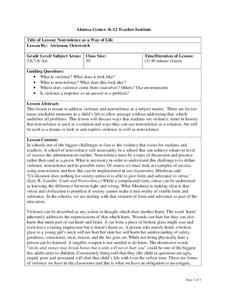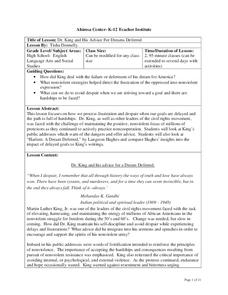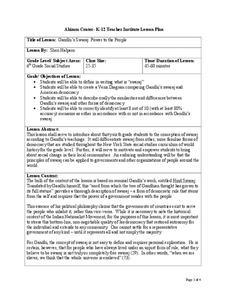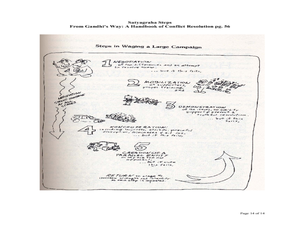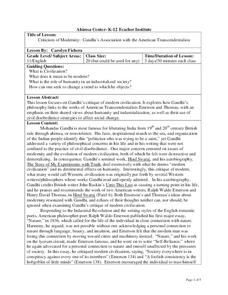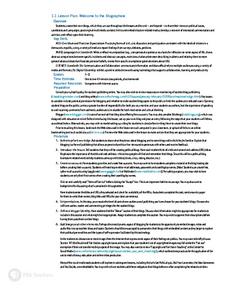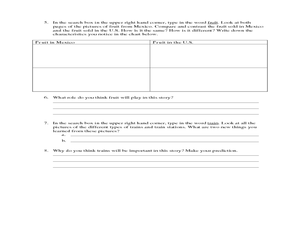Curated OER
Nonviolence as a Way of Life
Students investigate the example Gandhi set for others to not engage in violence when being oppressed. In this rebellion lesson, students identify violence and discuss how it is used and often ineffective. Students create a...
Curated OER
Ahimsa in Writers Workshop
Students investigate nonviolent lifestyles by researching the life of Gandhi. In this journalism lesson, students define the word ahimsa and how important nonviolence is when solving conflicts. Students create a timeline of...
Curated OER
Understanding the Theoretical Basis for Civil Disobedience
Students analyze Henry David Thoreau's 'On the Duty of Civil Disobedience' and Dr. Martin Luther King's "Letter from Birmingham Jail." In this civil disobedience lesson, students read Thoreau's essay and answer 6 questions for the...
Curated OER
Dr. King and His Advice for Dreams Deferred
Students analyze Dr. King's public addresses and Langston Hughes' poetry as a study of the Civil Rights' nonviolent approach to making an impact. In this protesting instructional activity, students read poetry of Hughes and...
Curated OER
Neighborhood Rubrics
Students use a rubric to analyze their neighborhood and write a persuasive essay about changes that should be made. In this writing lesson, students use a rubric to grade their neighborhood and brainstorm improvements. Students write a...
Curated OER
Canvas Transformations
Students transform the content of paintings currently in the collection hanging in the Utah Fine Arts Museum by using the four theatre techniques of storytelling, kinetics images, soundscapes, and ritual building.
Curated OER
Chiune Sugihara, Living by Gandhian Principles
Seventh graders read about Chiune Sugihara and analyze the moral situations he faced. For this morality lesson, 7th graders read chapters from A Special Fate, Chiune Sugihara: Hero of the Holocaust and analyze his moral decisions in the...
Curated OER
An Introduction to the Season for Nonviolence
Fourth graders create a Venn diagram and a cause and effect graphic organizer on Gandhi and King. In this non violence lesson plan, 4th graders compare the two non violent leaders and discuss and articulate non violent protests and write...
Curated OER
Gandhi's Swaraj: Power to the People
Sixth graders discover what a swaraj is. In this world history instructional activity, 6th graders create a Venn Diagram comparing Gandhi's swaraj to American's democracy.
Curated OER
Gandhi's Non-violent Revolutions: Examining Tools to Make Non-violent
Students analyze Gandhi's philosophy of nonviolent social change. In this nonviolence and social change lesson, students research a leader from the attached list who practiced nonviolent social change. Students write their own poem...
Curated OER
Tracing the Idea of Civil Disobedience through Thoreau, Gandhi, and King
Young scholars analyze civil disobedience through history studying Thoreau, Gandhi, and Dr. King. In this civil disobedience activity, students read and analyze excerpts from Thoreau, Gandhi, and Martin Luther King. Young scholars...
Curated OER
Criticism of Modernity: Gandhi's Association with the American Transcendentalists
Eleventh graders explore Gandhi's philosophy links to the works of American Transcendentalists Emerson and Thoreau. In this transcendentalism lesson, 11th graders discuss essential questions about civilization and modernity.
Curated OER
Welcome to the Blogosphere
Create a blog spot for your classroom and promote online discussions. There are several blogging websites listed here, and you can create one specific to each class or one collective site. Teach your learners how to post on the blog, and...
Curated OER
Esperanza Rising - Anticipation Guide
Learn about Mexican culture while simultaneously strengthening reading, writing and computer skills. In order to get the most out of Esperanza Rising, pupils should have prior knowledge of Mexican culture. Therefore, there are links to a...
Curated OER
Back to School: Style Analysis
Jump back into expository writing and analysis at the start of a new school year! Start with a review of an authors' stylistic choices in diction, syntax, treatment of subject matter, and figurative language. Writers choose a text to...
Code.org
Encoding B and W Images
Imagine drawing with zeros and ones. The third lesson in a unit of 15 introduces the class to creating black and white images. Pairs get together to create an encoding scheme in order to make these images. They move on to a...
Curated OER
Women's Lives in American Paintings
Students analyze paintings to determine characteristics of women and attitudes toward them in different time periods. They create a portrait of a woman and discuss their views of women through their own artwork.
Core Knowledge Foundation
Isn’t It Exciting? (The American Industrial Revolution and Urbanization)
America was built on the ingenuity, work ethic, and foresight of our ancestors. Sixth graders learn about the complex Gilded Age in American history, including the prominent inventors and captains of industry, and how they all connect...
Perkins School for the Blind
Conversation Skills
It is so important for learners with multiple disabilities to learn how to communicate for both social and functional reasons. Each child will choose a topic from the list and generate five questions related to that topic. They'll split...
Curated OER
2oth-Century Painters: Master of Color
Learners describe how the work of the artists reflected the their lives and times, and how they inspired new artistic movements. They compare and contrast the works of the two artists at different periods in their lives. Students view a...
Curated OER
Land of the Rising Sun
Students survey aspects of traditional and modern Japanese customs and beliefs in the seven lessons of this unit. Both the culture and the geography of the country are studied in this unit.
Curated OER
KS3 Bitesize
Students complete exercises using their five senses to improve their writing skills. In this writing skills instructional activity, students complete activities blindfolded and using their five senses. Students then select an abstract...
Curated OER
Keith Haring Painting Project
Students paint a picture based on the work of Keith Haring including Haring people. In this painting lesson plan, students also look and discuss the art of Keith Haring.
Curated OER
Four Armed Men From the Renaissance!
Students study the Renaissance and the important art from the period. In this Renaissance lesson, students discuss the black plague and religion during the Renaissance. Students read the Renaissance worksheet and learn vocabulary words...
